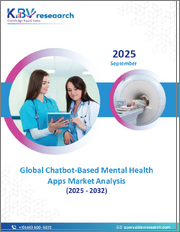
|
시장보고서
상품코드
1596869
챗봇 시장 규모, 점유율, 성장 분석 : 부문별 및 지역별 산업 예측(2024-2031년)Chatbot Market Size, Share, Growth Analysis, By Offering, By Type, By Bot Communication, By Channel Integration, By Business Function, By Vertical, By Region - Industry Forecast 2024-2031 |
||||||
챗봇(Chatbot) 시장 규모는 2022년 41억 달러로 평가되었고, 2023년 49억 2,000만 달러에서 2031년에는 246억 4,000만 달러로 성장 할 것으로 예상되며, 예측기간(2024-2031년) CAGR은 23.91%로 추이하며 성장할 전망입니다.
챗봇이 대화 방식으로 사용자 문의를 효과적으로 해석하고 응답할 수 있도록 지원하는 인공지능(AI)과 자연어 처리(NLP) 기술의 통합이 증가하면서 글로벌 챗봇 시장은 견고한 성장세를 보이고 있습니다. 이러한 확장은 기업이 챗봇을 활용하여 고객과 더욱 역동적으로 소통하는 Facebook Messenger, WhatsApp, WeChat과 같은 인기 메시징 플랫폼의 확산에 힘입어 더욱 가속화되고 있습니다. 고객 지원을 위한 비용 효율적인 대안으로 자리매김한 챗봇은 사람의 개입 없이 대량의 문의를 처리할 수 있는 능력으로 인해 다양한 산업 분야에서 빠르게 도입되고 있습니다. 또한, 고객 데이터를 활용하여 맞춤형 응답을 제공함으로써 개인화된 고객 상호작용을 강화하기 위해 챗봇을 도입하는 기업이 점점 더 많아지고 있습니다. 특히 주목할 만한 점은 원격 모니터링 및 복약 알림과 같은 서비스를 제공하는 의료 부문에서 챗봇의 활용이 증가하고 있다는 점입니다. 또한 소셜 미디어 및 이커머스 플랫폼과의 통합으로 개인화된 추천과 원활한 거래 프로세스가 가능해졌습니다. AI와 NLP 기술이 지속적으로 발전하고 효율적이고 개인화된 고객 지원에 대한 요구가 심화됨에 따라 챗봇 시장은 크게 성장할 것이며, 전 세계 기업의 고객 참여와 운영 효율성을 향상시키는 중추적인 솔루션으로 자리매김할 것입니다.
목차
소개
- 조사 목적
- 조사 범위
- 정의
조사 방법
- 정보 조달
- 2차 및 1차 데이터 방법
- 시장 규모 예측
- 시장 전제 조건 및 제한 사항
주요 요약
- 세계 시장 전망
- 공급 및 수요 동향 분석
- 부문별 기회 분석
시장 역학 및 전망
- 시장 개요
- 시장 규모
- 시장 역학
- 성장 촉진요인 및 기회
- 억제요인 및 과제
- Porter's Five Forces 분석 및 영향
- 경쟁 기업간 경쟁 관계
- 대체품의 위협
- 구매자의 협상력
- 신규 참가업체의 위협
- 공급기업의 협상력
주요 시장 인사이트
- 중요 성공 요인
- 경쟁도
- 주요 투자 기회
- 시장 생태계
- 기술 진보
- 규제 상황
- 특허 분석
- 밸류체인 분석
- 사례 연구 분석
- 고객 및 구매 기준 분석
- PESTEL 분석
- 거시경제지표
- 스타트업 분석
- 시장 매력 지수(2023년)
- 원재료 분석
- 공급망 분석
챗봇 시장 규모 : 오퍼링별
- 시장 개요
- 솔루션
- 독립형
- 웹 기반
- 메시징 기반
- 기타 솔루션(라이브 채팅 및 비디오 봇)
- 서비스
- 매니지드 서비스
- 전문 서비스
- 교육 및 컨설팅
- 시스템 통합 및 구현
- 지원 및 유지 보수
챗봇 시장 규모 : 유형별
- 시장 개요
- 메뉴 기반
- 언어 기반
- 키워드 인식 기반
- 문맥
- 하이브리드
- 음성 봇
챗봇 시장 규모 : 봇 커뮤니케이션별
- 시장 개요
- 문장
- 오디오/음성
- 비디오
- 이미지
챗봇 시장 규모 : 채널 통합별
- 시장 개요
- 메일과 웹사이트
- 모바일 앱
- 메시징 앱
- 전화/IVR
- 기타
챗봇 시장 규모 : 비즈니스 기능별
- 시장 개요
- 정보기술 서비스 관리(ITSM)
- 판매 및 마케팅
- 컨택 센터
- 재무와 회계
- 인사
- 운영 및 공급망
챗봇 시장 규모 : 업계별
- 시장 개요
- 소매업 및 전자상거래
- 통신
- BFSI
- 헬스케어 및 생명과학
- 미디어 및 엔터테인먼트
- 여행 및 호스피탈리티
- IT/ITES
- 에너지 및 유틸리티
- 정부 및 방위
- 기타 업종(제조, 건설 및 부동산, 자동차, 교육)
챗봇 시장 규모 : 국가별
- 북미
- 미국
- 캐나다
- 유럽
- 영국
- 독일
- 스페인
- 프랑스
- 이탈리아
- 기타 유럽
- 아시아 태평양
- 중국
- 인도
- 일본
- 한국
- 기타 아시아 태평양
- 남미
- 브라질
- 기타 남미
- 중동 및 아프리카
- GCC 국가
- 남아프리카공화국
- 기타 중동 및 아프리카
경쟁 정보
- 상위 5개사 비교
- 주요 기업 시장 포지셔닝(2023년)
- 주요 시장 기업이 채택한 전략
- 시장의 최근 동향
- 기업 시장 점유율 분석(2023년)
- 주요 기업 프로파일
- 기업 개요
- 제품 포트폴리오 분석
- 부문별 점유율 분석
- 수익의 전년 대비 비교(2021-2023년)
주요 기업 프로파일
- Google(미국)
- Microsoft(미국)
- IBM(미국)
- AWS(미국)
- Baidu(중국)
- Oracle(미국)
- SAP(독일)
- OpenAI(미국)
- Salesforce(미국)
- Meta(미국)
- Artificial Solutions(스웨덴)
- (24)7.ai(미국)
- Kore.ai(미국)
- Conversica(미국)
- Avaamo
- Haptik
- Inbenta
- Creative Virtual
- Personetics
결론 및 권장사항
LYJGlobal Chatbot Market size was valued at USD 4.1 billion in 2022 and is poised to grow from USD 4.92 billion in 2023 to USD 24.64 billion by 2031, growing at a CAGR of 23.91% in the forecast period (2024-2031).
The global Chatbot market is witnessing robust growth, underscored by the rising integration of artificial intelligence (AI) and natural language processing (NLP) technologies, which empower Chatbots to effectively interpret and respond to user inquiries in a conversational manner. This expansion is further fueled by the proliferation of popular messaging platforms like Facebook Messenger, WhatsApp, and WeChat, where businesses leverage Chatbots to engage with customers more dynamically. Positioned as a cost-effective alternative for customer support, Chatbots are rapidly being adopted across diverse industry verticals due to their ability to handle a high volume of inquiries without human intervention. Moreover, organizations are increasingly employing Chatbots to enhance personalized customer interactions, utilizing customer data to craft tailored responses. Particularly noteworthy is the growing application of Chatbots within the healthcare sector, providing services like remote monitoring and medication reminders. Additionally, their integration with social media and e-commerce platforms facilitates personalized recommendations and seamless transaction processes. As AI and NLP technologies continue to advance, and the need for efficient, personalized customer support intensifies, the Chatbot market is poised for substantial growth, positioning itself as a pivotal solution in enhancing customer engagement and operational efficiency for businesses worldwide.
Top-down and bottom-up approaches were used to estimate and validate the size of the Global Chatbot market and to estimate the size of various other dependent submarkets. The research methodology used to estimate the market size includes the following details: The key players in the market were identified through secondary research, and their market shares in the respective regions were determined through primary and secondary research. This entire procedure includes the study of the annual and financial reports of the top market players and extensive interviews for key insights from industry leaders such as CEOs, VPs, directors, and marketing executives. All percentage shares split, and breakdowns were determined using secondary sources and verified through Primary sources. All possible parameters that affect the markets covered in this research study have been accounted for, viewed in extensive detail, verified through primary research, and analyzed to get the final quantitative and qualitative data.
Global Chatbot Market Segmental Analysis
Global Chatbot Market is segmented by Offering, Type, Bot Communication, Channel Integration, Business Function, Vertical and region. Based on Offering, the market is segmented into Solutions (Standalone, Web-based), Services, Training and Consulting, System Integration and Implementation, Support and Maintenance. Based on Type, the market is segmented into Menu-based, Linguistic-based, Keyword Recognition-based, Contextual, Hybrid, Voicebots. Based on Bot Communication, the market is segmented into Text, Video, Audio/Voice. Based on Channel Integration, the market is segmented into Email and Website, Mobile Apps, Messaging Apps, Telephone/ IVR. Based on Business Function, the market is segmented into Information Technology Service Management (ITSM), Sales and Marketing, Contact Centers, Finance and Accounting, HR, Operations and Supply Chain. Based on Vertical, the market is segmented into Retail and eCommerce, Telecom, BFSI, Healthcare and Life Sciences, Media and Entertainment, Travel and Hospitality, IT and ITES, Energy and Utilities, Government and Defense, Other Verticals (Manufacturing, construction & real estate, Automotive, and education). Based on region, the market is segmented into North America, Europe, Asia Pacific, Latin America and Middle East & and Africa.
Driver of the Global Chatbot Market
The global chatbot market is being significantly bolstered by the growing demand for continuous customer support. As digital communication channels become more prevalent, consumers increasingly anticipate around-the-clock assistance. Chatbots address this expectation by offering real-time support at any hour, thereby serving as an attractive solution for businesses aiming to improve their customer service offerings. This shift towards automated, always-available customer interactions not only enhances user experience but also allows companies to optimize their human resources, further driving the adoption and expansion of chatbot technology in various sectors. The trend underscores the pivotal role chatbots play in modern customer service.
Restraints in the Global Chatbot Market
The global chatbot market faces significant restraints due to a pervasive lack of understanding regarding chatbot technology among both businesses and consumers. Even with the increasing integration of chatbots into various sectors, this limited comprehension can impede their widespread adoption and ultimately stall market growth. Many potential users may be hesitant to implement chatbot solutions if they do not grasp their benefits or functionality, leading to missed opportunities for enhanced customer engagement and streamlined operations. As a result, addressing the knowledge gap surrounding chatbot technology is crucial for overcoming these challenges and fostering a more robust market landscape.
Market Trends of the Global Chatbot Market
The Global Chatbot market is witnessing a significant upward trend driven by the escalating adoption of artificial intelligence (AI) and natural language processing (NLP) technologies. As organizations seek to enhance customer interactions and streamline operational efficiencies, the demand for advanced chatbot solutions is surging. These intelligent systems are evolving to comprehend and address intricate queries, enabling more natural and fluid conversations. This technological advancement not only improves user experience but also empowers businesses to provide personalized, 24/7 customer support, thereby fostering customer loyalty and driving revenue growth. Consequently, the market is poised for robust expansion, with continual innovations expected to shape its future trajectory.
Table of Contents
Introduction
- Objectives of the Study
- Scope of the Report
- Definitions
Research Methodology
- Information Procurement
- Secondary & Primary Data Methods
- Market Size Estimation
- Market Assumptions & Limitations
Executive Summary
- Global Market Outlook
- Supply & Demand Trend Analysis
- Segmental Opportunity Analysis
Market Dynamics & Outlook
- Market Overview
- Market Size
- Market Dynamics
- Driver & Opportunities
- Restraints & Challenges
- Porters Analysis & Impact
- Competitive rivalry
- Threat of substitute
- Bargaining power of buyers
- Threat of new entrants
- Bargaining power of suppliers
Key Market Insights
- Key Success Factors
- Degree of Competition
- Top Investment Pockets
- Market Ecosystem
- Technological Advancement
- Regulatory Landscape
- Patent Analysis
- Value Chain Analysis
- Case Study Analysis
- Customer & Buying Criteria Analysis
- PESTEL Analysis
- Macro-Economic Indicators
- Startup Analysis
- Market Attractiveness Index, 2023
- Raw Material Analysis
- Supply Chain Analysis
Global Chatbot Market Size by Offering & CAGR (2024-2031)
- Market Overview
- Solutions
- Standalone
- Web-based
- Messaging-based
- Other Solutions (Live chat and Videobots)
- Services
- Managed Services
- Professional Services
- Training and Consulting
- System Integration and Implementation
- Support and Maintenance
Global Chatbot Market Size by Type & CAGR (2024-2031)
- Market Overview
- Menu-based
- Linguistic-based
- Keyword Recognition-based
- Contextual
- Hybrid
- Voice bots
Global Chatbot Market Size by Bot Communication & CAGR (2024-2031)
- Market Overview
- Text
- Audio/Voice
- Video
- Images
Global Chatbot Market Size by Channel Integration & CAGR (2024-2031)
- Market Overview
- Email and Website
- Mobile Apps
- Messaging Apps
- Telephone/ IVR
- Others
Global Chatbot Market Size by Business Function & CAGR (2024-2031)
- Market Overview
- Information Technology Service Management (ITSM)
- Sales and Marketing
- Contact Centers
- Finance and Accounting
- HR
- Operations and Supply Chain
Global Chatbot Market Size by Vertical & CAGR (2024-2031)
- Market Overview
- Retail and eCommerce
- Telecom
- BFSI
- Healthcare and Life Sciences
- Media and Entertainment
- Travel and Hospitality
- IT and ITES
- Energy and Utilities
- Government and Defense
- Other Verticals (Manufacturing, construction & real estate, Automotive, and education)
Global Chatbot Market Size & CAGR (2024-2031)
- North America, (Offering, Type, Bot Communication, Channel Integration, Business Function, Vertical)
- US
- Canada
- Europe, (Offering, Type, Bot Communication, Channel Integration, Business Function, Vertical)
- UK
- Germany
- Spain
- France
- Italy
- Rest of Europe
- Asia-Pacific, (Offering, Type, Bot Communication, Channel Integration, Business Function, Vertical)
- China
- India
- Japan
- South Korea
- Rest of Asia Pacific
- Latin America, (Offering, Type, Bot Communication, Channel Integration, Business Function, Vertical)
- Brazil
- Rest of Latin America
- Middle East & Africa, (Offering, Type, Bot Communication, Channel Integration, Business Function, Vertical)
- GCC Countries
- South Africa
- Rest of Middle East & Africa
Competitive Intelligence
- Top 5 Player Comparison
- Market Positioning of Key Players, 2023
- Strategies Adopted by Key Market Players
- Recent Developments in the Market
- Company Market Share Analysis, 2023
- Company Profiles of All Key Players
- Company Details
- Product Portfolio Analysis
- Company's Segmental Share Analysis
- Revenue Y-O-Y Comparison (2021-2023)
Key Company Profiles
- Google (US)
- Company Overview
- Business Segment Overview
- Financial Updates
- Key Developments
- Microsoft (US)
- Company Overview
- Business Segment Overview
- Financial Updates
- Key Developments
- IBM (US)
- Company Overview
- Business Segment Overview
- Financial Updates
- Key Developments
- AWS (US)
- Company Overview
- Business Segment Overview
- Financial Updates
- Key Developments
- Baidu (China)
- Company Overview
- Business Segment Overview
- Financial Updates
- Key Developments
- Oracle (US)
- Company Overview
- Business Segment Overview
- Financial Updates
- Key Developments
- SAP (Germany)
- Company Overview
- Business Segment Overview
- Financial Updates
- Key Developments
- OpenAI (US)
- Company Overview
- Business Segment Overview
- Financial Updates
- Key Developments
- Salesforce (US)
- Company Overview
- Business Segment Overview
- Financial Updates
- Key Developments
- Meta (US)
- Company Overview
- Business Segment Overview
- Financial Updates
- Key Developments
- Artificial Solutions (Sweden)
- Company Overview
- Business Segment Overview
- Financial Updates
- Key Developments
- [24]7.ai (US)
- Company Overview
- Business Segment Overview
- Financial Updates
- Key Developments
- Kore.ai (US)
- Company Overview
- Business Segment Overview
- Financial Updates
- Key Developments
- Conversica (US)
- Company Overview
- Business Segment Overview
- Financial Updates
- Key Developments
- Avaamo
- Company Overview
- Business Segment Overview
- Financial Updates
- Key Developments
- Haptik
- Company Overview
- Business Segment Overview
- Financial Updates
- Key Developments
- Inbenta
- Company Overview
- Business Segment Overview
- Financial Updates
- Key Developments
- Creative Virtual
- Company Overview
- Business Segment Overview
- Financial Updates
- Key Developments
- Personetics
- Company Overview
- Business Segment Overview
- Financial Updates
- Key Developments



















